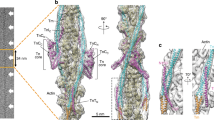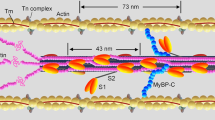Abstract
MANY muscles in the frog contain slow as well as twitch muscle fibres, which differ in their innervation, electrical and contractile properties and fine structure1. Slow fibres give graded slow contractions with nerve stimulation, and can maintain a prolonged contracture when depolarised. There is evidence that contractile activation in slow fibres is mediated by a rise in myoplasmic calcium concentration2, but it is not clear whether this calcium originates from the sarcoplasmic reticulum, as in twitch fibres, or enters the fibre from the external solution1,3–5. We have used the calcium indicator dye arsenazo III (refs 6–9) to follow changes in intracellular free calcium concentration occurring during depolarisation of slow fibres, and find that the membrane potential dependence of these calcium transients in slow fibres is very similar to that observed in twitch fibres9. The time courses of the calcium transients in slow fibres are, however, very much slower than in twitch fibres9,10, and may be a major factor in determining the time courses of tension development and relaxation.
This is a preview of subscription content, access via your institution
Access options
Subscribe to this journal
Receive 51 print issues and online access
$199.00 per year
only $3.90 per issue
Buy this article
- Purchase on Springer Link
- Instant access to full article PDF
Prices may be subject to local taxes which are calculated during checkout
Similar content being viewed by others
References
Lannergren, J. in Basic Mechanisms of Ocular Motility and their Clinical Implications (eds Lennerstrand, C. & Bach-y-Rita, P.) (Pergamon, Oxford, 1975).
Costantin, L. L., Podolsky, R. J. & Tice, L. W., J. Physiol., Lond. 188, 261–271 (1967).
Kirby, A. C. Am. J. Physiol. 219, 1446–1450 (1970).
Nasledov, G. A., Mandelstam, J. E. & Radzjukewich, T. L. Experientia 28, 1305–1306 (1972).
Gilly, W. F. & Hui, C. S. Nature 266, 186–188 (1977).
Brown, J. E. et al. Biophys. J. 15, 1155–1160 (1975).
Dipolo, R. et al. J. gen. Physiol. 67, 433–467 (1976).
Miledi, R., Parker, I. & Schalow, G. J. Physiol., Lond. 269, 11–13P (1977).
Miledi, R., Parker, I. & Schalow, G. Proc. R. Soc. B (in the press).
Taylor, S. R., Rudel, R. & Blinks, J. R., Fedn Proc. 34, 1379–1381 (1975).
Stefani, E. & Steinbach, A. B. J. Physiol., Lond. 203, 383–401 (1969).
Katz, B. & Miledi, R. J. Physiol., Lond. 192, 407–436 (1967).
Lannergren, J. Acta. physiol., scand. 69, 362–372 (1967).
Chandler, W. K., Rakowski, R. F. & Schneider, M. F. J. Physiol., Lond. 254, 285–316 (1976).
Page, S. G. J. Cell Biol. 26, 477–497 (1965).
Franzini-Armstrong, C. J. Cell Biol. 56, 120–128 (1973).
Bailey, C. H. & Peachey, L. D. J. Cell Biol. 67, 15a (1975).
Kuffler, S. W. & Vaughan Williams, E. M. J. Physiol., Lond. 121, 318–340 (1953).
Author information
Authors and Affiliations
Rights and permissions
About this article
Cite this article
MILEDI, R., PARKER, I. & SCHALOW, G. Calcium transients in frog slow muscle fibres. Nature 268, 750–752 (1977). https://doi.org/10.1038/268750a0
Received:
Accepted:
Issue Date:
DOI: https://doi.org/10.1038/268750a0
This article is cited by
-
Calcium transients in skeletal muscle fibres under isometric conditions and during and after a quick stretch
Journal of Muscle Research and Cell Motility (1991)
-
Effect of divalent cations on the potassium contracture of slow muscle fibers ofRana temporaria
The Journal of Membrane Biology (1987)
-
Voltage dependence of membrane charge movement and calcium release in frog skeletal muscle fibres
Journal of Muscle Research and Cell Motility (1985)
-
Sarcoplasmic Ca2+ transients during the contractile cycle of single barnacle muscle fibres: measurements with arsenazo III-injected fibres
Journal of Muscle Research and Cell Motility (1982)
-
Calcium transients in mammalian muscles
Nature (1980)
Comments
By submitting a comment you agree to abide by our Terms and Community Guidelines. If you find something abusive or that does not comply with our terms or guidelines please flag it as inappropriate.



